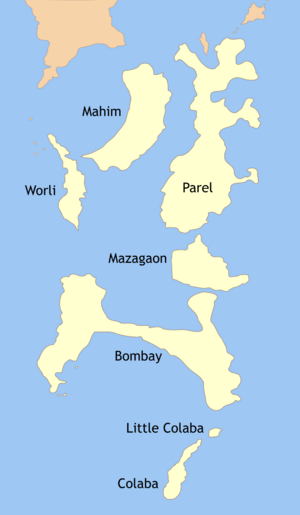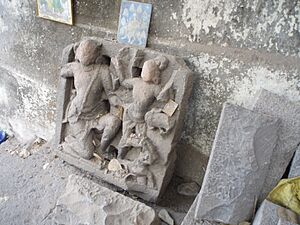History of Mumbai under indigenous empires facts for kids
The ancient history of Mumbai tells the story of this famous city from about 300 BCE to 1348 CE. Back then, Mumbai wasn't one big city like it is today. It was actually a group of seven separate islands!
Contents
Early Days of the Islands
Long, long ago, Mumbai was a cluster of seven islands. Scientists have found old tools and signs of people living on these islands since the Stone Age. This means people have called this area home for thousands of years!
The islands got their name from a goddess named Mumbadevi, who was worshipped by the Kolis, the original fishing community living there. A nearby port called Sopara (now Nala Sopara) was a busy place for trading goods in ancient times.
Under the Mauryan Empire
Around 300 BCE, a powerful ruler named Emperor Ashoka from the Maurya Empire took control of these islands. His empire was very large and helped spread new ideas. Because of the Maurya Empire's influence, the islands became important centers for Hindu and Buddhist religions and cultures.
Buddhist monks, smart scholars, and talented artists created amazing artwork, carvings, and statues in places like the Kanheri Caves and Mahakali Caves. There were 109 Buddhist cave temples in total, built starting from the late 2nd century BCE.
After the Maurya Empire became weaker around 185 BCE, the islands were then ruled by a group called the Satvahanas.
New Rulers and Kingdoms
The ancient Greeks knew these islands too! A Greek mapmaker named Ptolemy called them "Heptanesia," which means "A Cluster of Seven Islands," around 150 CE.
After the Satvahana rule ended in 250 CE, different groups took over. The Abhiras ruled for about 167 years, followed by the Kalachuris in the 5th century. Later, the Mauryas of Konkan, who were connected to the Kalachuris, took charge. The famous Jogeshwari Caves were built during their time, between 520 and 550 CE.
The Mauryan rule ended when the Chalukyas, led by Pulakeshin II, invaded the islands in 610 CE. Then, in 749–750 CE, Dantidurga of the Rashtrakuta Dynasty conquered Mumbai.
The Silhara Dynasty
A very important period for the islands was when the Silhara dynasty ruled, from 810 to 1240 CE. These rulers helped build many famous places that you can still see today, like the Banganga Tank, the Walkeshwar Temple, and the incredible Elephanta Caves.
Later Hindu Rulers
In the 13th century, a famous Italian explorer named Marco Polo sailed past the islands of Mumbai.
Around this time, a local ruler named King Bhimdev built his capital city in a place called Mahikawati, which is now known as Mahim and Prabhadevi. After he passed away in 1303, his son Pratapbimba became king. Pratapbimba built his own capital city called Pratappur in Marol, on Salsette island.
The islands faced challenges when Mubarak, the emperor of Delhi, took control of Mahim and Salsette in 1318. But Pratapbimba fought back and got his lands again, ruling until 1331. Later, his brother-in-law, Nagardev, ruled for 17 years until 1348.
In 1348, the islands came under the control of the Muzaffarid dynasty from Gujarat. This marked the end of the long period where Hindu rulers governed the islands of Bombay.



